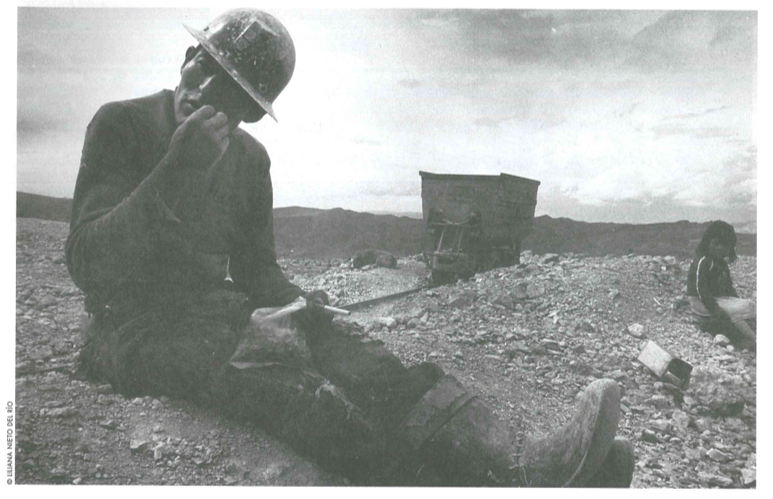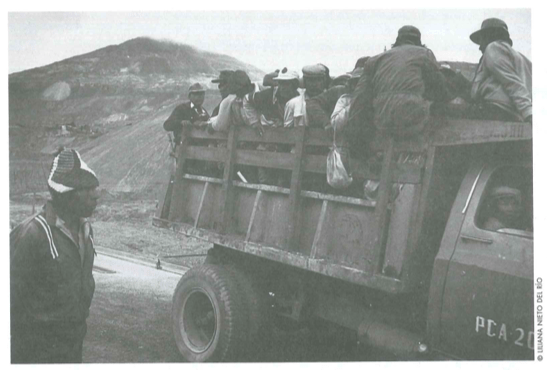Economic Insecurity in Latin America
Cutting Across Class Lines

Working in Bolivia: Miners of Cerro Rico, Potosí. Portraits of Latin American work: ers, the backbone of the economy, will be featured throughout this issue.
A 23-year old Brazilian woman was among 10,000 job applicants seeking a desk job at Banco do Brazil. When asked why she was seeking employment that actually paid less than her present salary, she was quoted as replying, “I need stability in my life.” The New York Times (August 26, 1999, C4) recently highlighted this poignant example of economic insecurity in Brazil. One out of every 160 Brazilians were competing in August 1999 for jobs at this bank, a government run institution that “pays salaries on time and in full” and provides comprehensive health insurance and pension benefits, according to theTimes article.
During the 1990s Latin America’s per-capita income grew at an average rate of two percent per year, after having fallen at a rate of one percent during the 1980s. Despite the recovery, however, the region remains gripped with a disconcerting level of economic insecurity. The view that pervasive economic insecurity threatens political support for the ongoing market-oriented reforms is a common refrain in current discussions on Latin American affairs.
A large, cross-national survey of 14 Latin American countries recently found that 61 percent of respondents believed their parents had lived “better” than they do while less than half (46 percent) believed their children would live better than themselves. Almost three-quarters of the respondents favored increased spending on unemployment insurance, and more than 80 percent expressed a desire for more spending on pensions. Moreover, the responses were fairly uniform regardless of income levels, educational background or type of employment. Surveys of this type suggest a pervasive sense of economic insecurity in Latin America and a corresponding demand for social insurance, both of which appear to cut across class lines. In fact, in some of the largest countries of Latin America–Argentina, Brazil, Mexico, and Venezuela in particular–the middle-income groups are more pessimistic about their children’s future than the lowest-income groups.
How do policy makers make progress on this issue? A first step is understanding the root causes of economic insecurity. In this article, I discuss some of the contributing factors.

Working in Bolivia: the Cerro Rico Potosi silver mine.
The trauma of the 1980s
The debt crisis of 1982 engulfed Latin America in a deep and prolonged recession, reminiscent in some ways of the Great Depression in the United States during the 1930s. During the Great Depression, incomes declined on average by 35 percent between 1929 and 1933, and unemployment peaked at 25 percent (in 1933). The decline in real incomes (and rise in unemployment) was not as steep in Latin America after 1981. However, with the notable exception of Chile, the recovery in Latin America was more gradual. Moreover, the United States economy, boosted in part by World War II, experienced a much faster rate of expansion in the 1940s than it had during the 1920s. Latin America’s growth rate during the 1990s has failed to match the record of the 1960s and 1970s.
The United States responded to the Great Depression with a series of major institutional innovations that greatly expanded the role of the government in the economy and for the most part represented a sharp break with the past. Many of these innovations took the form of social insurance: social security, unemployment compensation, public works, public ownership, deposit insurance, and legislation favoring unions were among the new mechanisms created to deal with the perceived shortcomings of the private marketplace.
In Latin America, the upshot of the debt crisis was a series of reforms that actually served to weaken institutions of social insurance. Employment generally became less secure, and publicly provided safety nets were weakened. One reason is that Latin America entered the 1980s from a very different vantage point than the United States had entered the 1930s. Most of the countries of the region had industrialized behind government-imposed trade restrictions, public enterprises had become commonplace, and fiscal deficits and macroeconomic mismanagement were the proximate causes of the debt crisis. Governments were seen as part of the problem rather than as the solution.

Working in Guatemala: In the Market.
Structural reforms and the decline of job protection
Moreover, the reforms that Latin America adopted in the 1980s–privatization, deregulation, trade liberalization, and financial liberalization– had the predictable effect of increasing risk for workers and households. While there has not been much change in formal legislation on employment protection, the available evidence suggests that the proportion of workers with “secure” jobs has declined in practically all countries of the region for which relevant data exist.
One indication of this is the sharp reduction in trade union strength since the 1980s, in all countries except for Chile. This is significant since bargaining for greater job security on behalf of their members is a key function of trade unions. Another indicator of job insecurity is the proportion of workers that are not “protected” by formal written contracts or inclusion in social benefit programs. By this measure, all Latin American countries with available data have experienced a decline in job protection (see accompanying table). The fact that the informal economy -according to the International Labor Organization- accounts for 80 percent of new jobs created in Latin America over the last two decades is telling in its own right.
Has the evident decline in job protection been compensated by lower rates of unemployment overall? The answer is no. While unemployment fell during the late 1980s, it has subsequently risen since the mid-1990s. It is striking that at least eight of the countries in the region (Argentina, Brazil, Ecuador, Mexico, Nicaragua, Peru, Paraguay, and Venezuela) had higher unemployment rates in 1994-98 than they did during 1981-88.
Erratic capital flows
While the fear of a drastic reduction in income associated with job loss and unemployment is an important part of economic insecurity, another is volatility in the household income stream. As Latin America entered the 1990s it found itself in a world of high macroeconomic volatility. On the average, volatility in Latin America-measured by the standard deviation of Gross National Product (GNP) growth rates-tends to be double the level of industrial economies.
This volatility is increasingly driven by erratic private capital flows. In fact, for the 1990s the evidence suggests that the instability in private capital flows has been the most important single determinant of macroeconomic volatility. Some of the smaller countries of the region with comparatively little access to private capital flows (Bolivia and Guatemala) have experienced the lowest levels of macroeconomic volatility. Argentina and Venezuela are at the other extreme, with very high levels of exposure to volatility in private capital flows and correspondingly high levels of macro volatility. Countries like Brazil, Chile, and Colombia, which have managed private capital flows, are somewhere in between.
The spread of international financial markets and the region’s enthusiastic embrace of them have left macroeconomic policy hostage to short-term investors. Key instruments such as fiscal policy and the exchange rate have been increasingly determined by capital flows and can no longer be targeted on domestic stability. The result is a divorce between macroeconomic policy and the real economy.
The importance of institutions of voice
A key shortcoming of Latin American social and political institutions is that they have not been adequately responsive thus far to the clamor for greater economic security. As mentioned above, states have retrenched rather than take on the added responsibilities that managing risk in market-oriented societies requires. But the problem goes beyond governments. Political systems as a whole have failed to create viable mechanisms of voice: national legislatures have been fragmented and unrepresentative, and political parties weak. Trade unions have been unable to develop an adequate and encompassing strategy for dealing with job insecurity and have lost members. And the monopolization of policy discussions around a narrow, Washington-consensus view of development policy, sharply constrained by the “requirements” of global economic integration, has prevented the emergence of an alternative (or at least complementary) vision of economic reform driven by local concerns and national aspirations.
The demise of military rule and the transition to democracy have been the most encouraging developments to take place in Latin America during the last two decades. Econometric work and a range of case studies suggest that the degree to which a political system is open to participation from below does affect the quality of macroeconomic management for the better. Participation helps in a number of different ways. First, democracy allows a smooth transfer of power from failed policies and politicians to a new group of government leaders. Second, participation enables mechanisms of consultation and bargaining, allowing policy makers to fashion the consensus needed to undertake the necessary policy adjustments decisively. Third, institutionalized mechanisms of “voice” obviate the need for riots, protests, and other kinds of disruptive actions by affected groups, as well as lowering the support for such behavior by other groups in society.
Yet social and political institutions in Latin America retain a number of important weaknesses despite the transition to democracy. Trade unions, an important institution of collective voice, have lost membership in most countries (with the exception of Chile). The old style of trade union activity, consisting of lobbying for legally mandated job protections and wage advantages, is arguably not well suited to the requirements of economies with competitive markets and smaller production units. Neither trade union leaders nor policy makers have yet been able to fashion an environment in which unions are seen as responsive to the needs of workers.
The broader political system in Latin America is faced with what Jorge DomÃnguez has called a “crisis of representation.” Government officials in Latin America are perceived as corrupt, political parties as a collection of factions, legislatures as ineffective, and presidents as either saviors or rascals to be impeached. While military coups have all but disappeared, new forms of threat to constitutionalism have emerged, as DomÃnguez emphasizes, in the form of rule by presidential decree, mutinies led by disgruntled middle-ranking military officers, or presidential “coups” against the legislature.

Working in Azuay Ecuador: Rosa harvesting corn.
Looking forward
Economic insecurity in Latin America is multifaceted and has many sources that feed on each other. Some of the insecurity arises from the decline in employment protection and increased volatility of household outcomes. Some of it is the result of erratic capital flows and the systemic instability generated by a divorce between the instruments of stabilization and the real economy. Finally, an important component is the weakness of the institutions of voice and representation.
An important implication is that programs aimed at social protection per se will not make much of a dent in the situation. Well-functioning safety nets-unemployment compensation, old-age and medical benefits, targeted social funds-may help cope with some of the idiosyncratic risks that households face. But they will have to be complemented by macroeconomic policies (with regard to capital flows and the exchange rate in particular) that are more conducive to the stability of the real economy. They will also require access to representative institutions-trade unions, political parties, and legislatures-with greater responsiveness and legitimacy than those that exist presently.
But perhaps what Latin America needs most is a vision of how social cohesion can be maintained in the face of large inequalities and volatile outcomes, both of which are being aggravated by the growing reliance on market forces. In today’s advanced industrial countries, the expansion of markets’ role historically has gone hand in hand with the strengthening of the institutions of social insurance. Since the New Deal in the United States, and even more so since World War II in Europe, that has meant the growth of the public sector and the erection of a welfare state. If Latin America is to carve a different path for itself, the region will have to develop an alternative vision that articulates how the tension between market forces and the yearning for economic security can be eased.
The good news is that this question is at least being addressed. The bad news is that no-one, least of all economists, have a very useful answer to offer so far.
The Decline of Employment Security
| Country | Trade Union Membership (thousands) | Trade Union Density (% of Non-AGR Labor Force) | “Unprotected” Employees (% of employees) |
| Argentina | 1986 3262 | 1986 48.7 | 1990 21.7 |
| 1995 3200 | 1995 25.4 | 1996 34 | |
| Bolivia | 1994 276 | 1994 16.4 | 1991 28 |
| 1997 34.8 | |||
| Brazil | 1991 15205 | 1991 32.1 | 1985 63.6 |
| 1996 68.5 | |||
| Chile | 1985 361 | 1985 11.6 | 1990 17 |
| 1993 103 | 1993 15.9 | 1996 22.3 | |
| Colombia | 1985 877 | 1985 11.2 | |
| 1995 840 | 1995 7.0 | ||
| El Salvador | 1985 79 | 1985 54.1 | 1994 59.1 |
| 1995 103 | 1995 7.2 | 1997 61.3 | |
| Mexico | 1989 9500 | 1989 54.1 | 1990 43.4 |
| 1991 7000 | 1991 31.0 | 1997 49.6 | |
| Peru | 1991 442 | 1991 7.5 | 1990 25.5 |
| 1996 34.1 | |||
| Uruguay | 1990 222 | 1990 19.9 | |
| 1993 151 | 1993 11.6 | ||
| Venezuela | 1988 1700 | 1988 25.9 | |
| 1995 1153 | 1995 14.9 |
Source: See Rodrik, “Why Is There So Much Economic Insecurity in Latin America?” for original sources.
Note: “Unprotected” employment refers to the proportion of employees without written contract or social benefits, depending on the country. Employees covered refer to private sector or urban employment.
Fall 1999
Dani Rodrik is Professor of International Political Economy at the John E. Kennedy School of Government, Harvard University. This article is based on a larger study prepared by the author for the World Bank. For fuller documentation and references, please see “Why Is There So Much Economic Insecurity in Latin America?” which can be downloaded from http://www.ksg.harvard.edu/rodrik/papers. html. The author is grateful to Mary Gardner Abbott for help in shortening the paper.
Related Articles
Its Strengths, Problems, and Future
Latin America can take a punch. Its endurance of a whole series of rather large shocks in the last two years is a tribute to the region’s extensive structural reforms. The consequences a decade…
Health and Wealth
The difficulties of operating in a tropical environment were already abundantly clear during the building of the Panama Canal more than a hundred years ago. “The effect of the climate on tools…
Zamorano and its Neighbors
We walked along together, 12-year-old Lizet and I, down the narrow, ragged paths that connected the various houses of El Chaguite to one another. “Let’s call in from here,” Lizet said…




